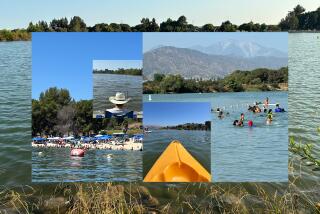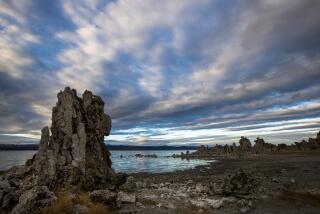Picture-perfect waters
- Share via
LEE VINING, CALIF. — In summer, thousands of visitors converge on Mono Lake to see its tufa formations and enjoy its remarkable scenery. Motels and restaurants are jammed, and the small town of Lee Vining, which sits at the eastern gateway to Yosemite National Park -- bustles.
But in winter, when the area is sugarcoated with fresh snow, the experience is much more serene, a good time to enjoy the beauty of the lake and the near solitude.
Besides, getting to Mono Lake is easy. It takes less than six hours to drive north from Los Angeles to Lee Vining, and most of it is along scenic U.S. Highway 395 as the Sierra’s snowcapped summits urge you onward.
Mono Lake was formed about a million years ago, making it one of the oldest lakes in North America. The lake is 6,382 feet above sea level and sprawls across more than 45,000 acres. It’s almost three times saltier than the Pacific Ocean. This inland sea contains brine shrimp, algae and alkali flies, which provide food for the thousands of birds that gather here during much of the year.
Mark Twain once said of Mono Lake, “There are no fish in Mono Lake -- no frogs, no snakes, no pollywogs -- nothing, in fact, that goes to make life desirable.” But then, Twain was known to be a bit grumpy, and he probably never visited the lake in winter.
My longtime partner, Gloria, and I were undaunted by Twain’s comments and decided to explore the wintry aspects of Mono Lake for ourselves in February. After cruising through Lone Pine and Bishop and continuing on past Mammoth Mountain, we arrived in time to see the afternoon sun glinting off the lake’s surface.
We stopped first in Lee Vining at the office of the Mono Lake Committee, where an extensive collection of guidebooks, maps and other information is available about the lake and the region. The office is open seven days a week, and visitors are encouraged to ask questions. Geoff McQuilkin, the committee’s executive director, told us, “Mono Lake is an exceptional experience any time of year. But, in winter, you get a sense of the lake’s entire water cycle and how the system works. And you get the fabulous scenic views, because the lake highlights them.”
Indeed, the lake does highlight the surrounding scenery. At sunrise and sunset, the snowy mountains glow red, yellow and orange at their most intense. Those colors also are reflected on the lake’s surface and on the multifaceted tufa formations that rise up like otherworldly sentinels.
In fact, this winter setting has become a draw for nature photographers who sign up for special winter tours designed just for them. These increasingly popular photo expeditions are usually headquartered at Murphey’s Motel in Lee Vining, where managers Bill and Nancy Boman answer questions and post some of their images on the office walls. We chose to stay there too, because we were told “that’s where the photographers all hang out.” The fact that the rooms were snugly warm, well-equipped and comfortable didn’t hurt either.
However, the biggest draw for most people are the tufa formations. The most often asked question at the Mono Lake Committee’s office is, “Where is the South Tufa grove?” Tufa is rock composed of calcium carbonate, or common limestone. It is formed when calcium-rich underwater springs in the lake combine with carbonates, known to cooks as baking soda, in the water. The result is calcium carbonate, which settles around the springs. Decades or even centuries later, these tufa formations slowly grow into towers that may climb to more than 30 feet tall. All this takes place underwater. So, if you had visited here before lake level plummeted following water diversions in 1941, you would not have seen them.
Today, they are a source of visitor amazement. In fact, they are so popular that, in 1981, the California Legislature established the Mono Lake Tufa State Natural Reserve to protect these somewhat fragile towers.
The tufa towers are even more striking in winter when snow clings to their rough surfaces. The snow does not last long around the lake because the water is so salty. But while it lasts, it creates a very unusual scene.
Our first morning in Lee Vining, there was almost a foot of fresh snow on the roof of our car. We forgot about breakfast, hurriedly threw on our parkas and headed over snow-covered roadways to the county park on the north side of the lake. There, a boardwalk provides access to one section of the lake. Because of its design, we were able to walk among some tufa towers on our way to the water’s edge. Our warm breath hung in the chill air, and the fresh snow squeaked beneath our boots. After a round of picture-taking, I happily stepped into a pair of cross-country skis and glided off to view other parts of the lake.
That ski tour was a reminder that there is more to do at Mono Lake in winter than just sightsee. Opportunities for cross-country skiing are almost endless. For those with the necessary skills, backcountry skiing in the area is outstanding. Nearby June Mountain offers alpine skiing, with a wonderful view of Mono Lake from the top of the ski area. The better-known Mammoth Mountain ski area is not far away, and it is not unusual for skiers there to take a break from the lift lines and spend a day at Mono Lake.
Other activities include snowshoeing, snowmobiling and watching bald eagles from the June Lake loop and along the Walker River near Bridgeport. The famous gold-mining ghost town of Bodie remains open year-round, and winter access on snowmobiles or cross-country skis is a fascinating trip. However, check with the park rangers about rules and restrictions before heading to the old remnant of the region’s gold-mining days.
While we were in the area, we learned that efforts have begun to open the U.S. Forest Service visitor center for the winter. At the moment, the center, with its great view of Mono Lake, is closed during the winter months.
As ranger Jon Kazmierski told us, “We have to heat it. This building was designed when energy was less expensive. Since then, technologies have improved. If we can make these changes, . . . we will able to open up and provide services year-round.”
Lee Vining also has become a mecca for ice climbers. Frozen waterfalls in Lee Vining Canyon are known worldwide and offer multi-pitch routes ranging from beginner to expert level. Legend has it that it was on these frozen waterfalls that mountaineer and inventor Yvon Chouinard developed the tools that led to the modern ice-climbing revolution.
Veteran ice-climbing, skiing and mountaineering guide Robert S.P. Parker of the Sierra Mountain Center told us, “Lee Vining Canyon overall is a good place to learn ice climbing. Most of the routes can be top-roped, which makes it easier. You can go from the top down rather than the bottom up.”
We got to wondering how Lee Vining got its name. Originally the town was named Lakeview, but it turned out that another California town had already claimed the name. So, the town fathers decided to name it after local miner and sawmill operator Leroy Vining. He had traveled from the small town of La Porte, Ind., to California in search of gold. (Coincidentally, La Porte is my hometown.)
Mono Lake also has an interesting winter phenomenon -- the pogonip fog. From time to time, this fog, which consists of ice crystals, rises like a dark cloud from the lake. Sometimes, it even creates “fogbows” -- rainbows in the fog created by sunlight on the ice crystals.
We stood at the South Tufa area on the banks of the lake and watched as the fog slowly rose, providing a dark gray screen through which very little light passed. The snow had fallen recently, and ours were the only footprints. The fog created an almost eerie light that helped inform our photos of the tufa towers. If Mark Twain had been with us, he might have reconsidered his harsh assessment.
--
--
BEGIN TEXT OF INFOBOX
If you go
THE BEST WAY TO MONO LAKE
Driving: Take Interstate 5 north to California 14 north to U.S. 395 north, about six hours.
Flying: Horizon Air has flights into the Mammoth Lakes area. Restricted round-trip fares begin at $198. Car rentals are available there.
WHERE TO STAY
Most of the motels close during the winter, but Murphey’s Motel is open year-round. (800) 334-6316, www.murpheysyosemite.com
Lake View Lodge also is open. (760) 647-6543. Several other motels are open and easily reached in nearby June Lake.
WHERE TO EAT
Nicely’s Restaurant on Highway 395, (760) 647-6477, is the only dining spot open in Lee Vining during the winter, but it is closed midweek. The local market, however, has fresh sandwiches, etc. There also are plenty of places to eat in nearby June Lake.
WHAT TO DO
These places offer extensive ice climbing, backcountry skiing and other guided programs.
Sierra Mountain Center
174 W. Line St., Bishop; (760) 873-8526, www.sierramountaincenter.com
Sierra Mountain Guides, 148 Willow St., Bishop; (877) 423-2546, www.sierramtnguides.com
SKIING
June Mountain, (888) 586-3686, www.JuneMountain.com
TO LEARN MORE
Mono Lake Committee, (760) 647-6595, www.monolake.org
Mono Basin Scenic Area, (760) 647-3044 (closed for winter, tentatively scheduled to reopen in April).
Mammoth Lakes Welcome Center, (760) 924-5500
Bodie Ghost Town, (760) 647-6445
More to Read
Sign up for The Wild
We’ll help you find the best places to hike, bike and run, as well as the perfect silent spots for meditation and yoga.
You may occasionally receive promotional content from the Los Angeles Times.






